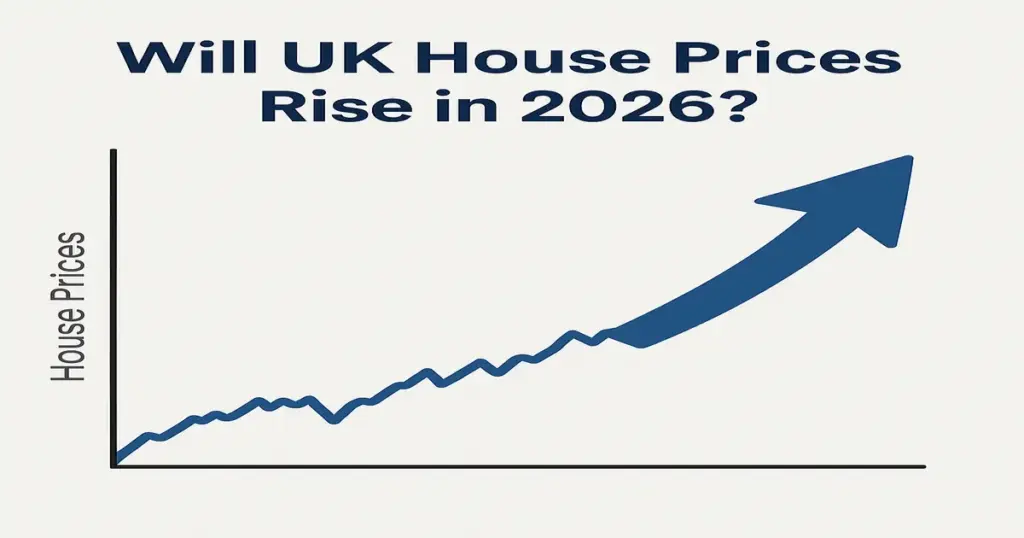Will the UK House Prices Rise or Collapse in 2026?
Current Market Context (Spring 2025)
As of May 2025, UK house prices have proven more resilient than many predicted. Prices have risen consistently for several months, defying earlier forecasts of a sharp downturn.
This resilience has been driven by low unemployment, steady wage growth, and improving affordability due to slightly easing mortgage rates.
Inflation has been persistent, currently running at around 3.5%, which has led the Bank of England to adopt a cautious approach to rate cuts. While mortgage rates have come down from the highs of 2024, they remain elevated compared to the pre-pandemic period.
Key Factors Shaping the 2026 Forecast
Interest Rate Outlook
The Bank of England has gradually reduced rates from a high of 5.25% to around 4.25%. At the same time, further cuts are expected but likely to be modest due to lingering inflation. Some analysts predict the base rate could settle between 3.7% and 4.2% in 2026, possibly easing further if inflation declines.
This means mortgage rates may remain higher than average throughout 2025 and only gradually ease in 2026. While this will help affordability somewhat, it will unlikely lead to a dramatic price boom.
Supply and Demand Dynamics
Despite the cost pressures, demand remains strong. Wage growth has supported buyer confidence, and housing supply remains limited. New home building continues to lag behind demand, and the resurgence of buy-to-let lending is tightening rental supply, further supporting house prices.
Regional Variations
Growth is not uniform across the UK. Markets in London and the southeast may behave differently from the national average, with some areas seeing stronger or weaker performance depending on local demand and supply conditions. Areas with significant undersupply may continue to outperform.
Expert Forecasts for House Prices in 2026
A range of forecasts from major institutions suggestss that UK house prices will rise in 2026, although expectations vary:
- Knight Frank predicts around 3% growth in 2026.
- Hamptons anticipates around 3.5% growth.
- Savills is more optimistic, expecting prices to rise by 5.5%.
- Capital Economics forecasts a 4.5% increase.
- Other forecasters estimate more modest growth between 2% and 3.5%.
The consensus among analysts is that house prices will continue to rise in 2026 but at a moderate pace compared to earlier housing booms.
Risks & Headwinds
Several risks could affect the housing market in 2026:
- Inflation: If inflation remains high, the Bank of England may delay further interest rate cuts, keeping mortgage rates elevated and limiting affordability.
- Economic Slowdown: A weaker economy could dampen demand for property and lead to slower price growth or even temporary declines in some regions.
- Policy Uncertainty: Changes in government housing policy, tax regimes, or regulation could impact market sentiment.
- Mortgage Remortgaging: Many homeowners will need to refinance in 2025–2026, potentially at higher rates than their previous deals, which could strain budgets.
Will House Prices Rise in 2026?
The short answer is yes, most likely.
While forecasts vary, nearly all point toward positive growth in 2026. The expected range of growth falls between 2.5% and 5.5%, with more conservative estimates around 3% and more optimistic ones approaching 5.5%.
Continued wage growth, limited housing supply, and the gradual easing of mortgage rates are expected to support this moderate increase in house prices.
What That Means for Buyers, Sellers, and Investors
For First‑time Buyers
Affordability remains a challenge. Although wage growth helps, mortgage rates are still higher than in previous years. That said, if rates ease later in 2026, buying conditions may improve slightly, offering a window of opportunity for some first-time buyers.
For Homeowners and Sellers
Modest price gains mean a typical home could increase in value by several thousand pounds in 2026. This may not represent a huge windfall, but it does support gradual equity growth. Sellers will need to price realistically, especially in slower-moving markets.
For Investors and Landlords
Buy-to-let lending is increasing again, and although there are some regulatory headwinds, tight rental supply and rising rents offer support. Investors can expect rental yields and property values to grow in tandem, albeit moderately.
Key Indicators to Watch (May 2025 Snapshot)
- Inflation: ~3.5%
- Base Interest Rate: ~4.25%
- Average Mortgage Rates: 4–5%, with some deals under 4%
- Wage Growth: ~6% year-on-year
- Forecast Price Growth (2026): 2.5%–5.5%
FAQs
Is a 5–10% annual house price rise realistic in 2026?
No. Most expert forecasts fall between 2.5% and 5.5%. Double-digit growth is improbable unless there is a dramatic change in economic conditions, such as unexpectedly large interest rate cuts or a surge in demand.
What could derail growth in 2026?
Key risks include persistently high inflation, a recession, policy shocks, or if mortgage rates remain high. Any of these could limit buyers’ affordability and reduce demand.
Could certain regions outperform?
Yes. Areas with substantial employment, good transport links, and limited housing stock could see faster price growth. Some commuter towns and smaller cities may outperform the national average.
Do mortgage rates drive everything?
They play a significant role. High rates reduce affordability, while lower rates boost it. Demand could strengthen if the Bank of England cuts rates further in 2026. If reductions are delayed, the market may cool.
How are wages influencing the market?
Wage growth of around 6% is helping to offset some of the affordability issues caused by higher interest rates. As long as wages continue to rise, they will support house prices.
What should I think about as a potential buyer?
Set realistic expectations. Prices are likely to rise, but not rapidly. Moderate growth is still a good sign if you’re buying for the long term. Watch interest rates and local market trends.
What about investors or landlords?
Expect moderate capital gains and rising rents. Be prepared for regulatory changes and factor them into your investment strategy. Focus on high-demand areas with low vacancy rates.
Does the government plan any housing reforms that matter?
Yes. Potential changes include stronger renter protections, new rules on property maintenance, and tax policy shifts. These may affect landlord profitability and buyer incentives.
If price growth is mild (~3%), is now a bad time to buy?
Not necessarily. Even moderate growth builds equity over time. Buying now can still be a sound financial move if you plan to stay in the property for several years.
What do long-term projections say?
Long-term trends suggest continued house price growth in line with inflation and earnings. While year-to-year performance will vary, the broader trajectory remains upward, barring major shocks.
Final Take: Will 2026 See House Price Growth?
Yes. Most major forecasters agree that UK house prices will rise in 2026, though not dramatically. The average forecast is for growth between 3% and 5%, driven by improving affordability, wage increases, and structural supply shortages.
The outlook is broadly positive, while risks remain, especially inflation and interest rates. For buyers, sellers, and investors, 2026 offers stable and moderate opportunities rather than dramatic changes.
UK Housing Market and Property Prices
HM Land Registry – UK House Price Index
Official monthly data on property transactions and prices by region
Read our top Blogs:
Sell My Property Fast For Cash In Wandsworth
What to Do If Your House Won’t Sell: Fast Solutions That Work
How to Sell a House Fast: Proven Tips to Get a Quick Sale Without Estate Agents
Call +447702210159 our friendly team for a same-day offer





